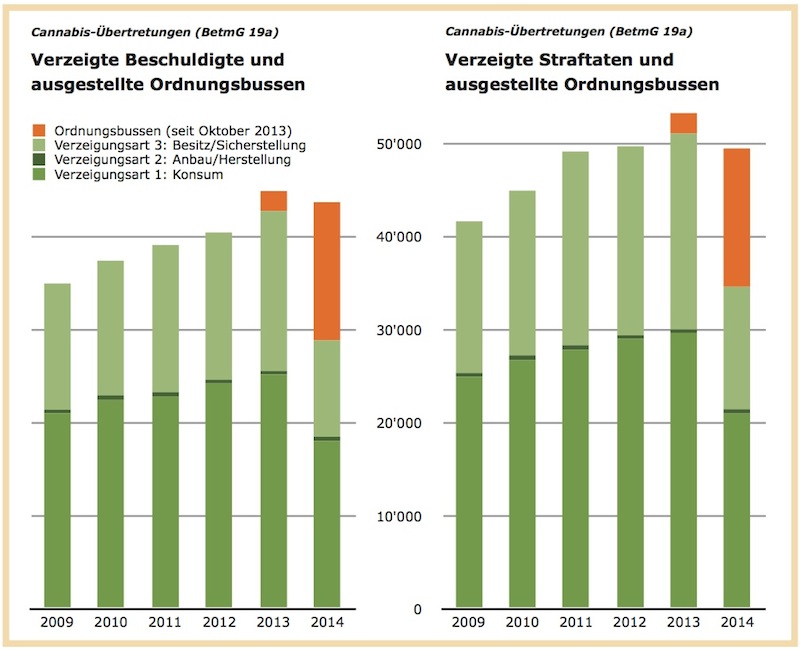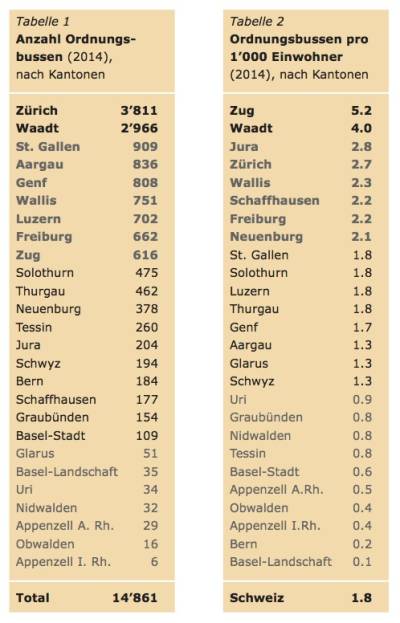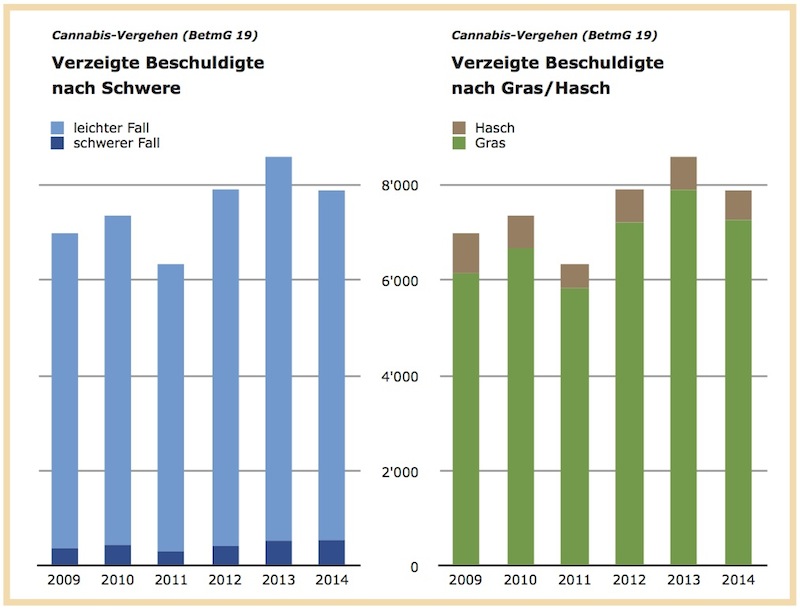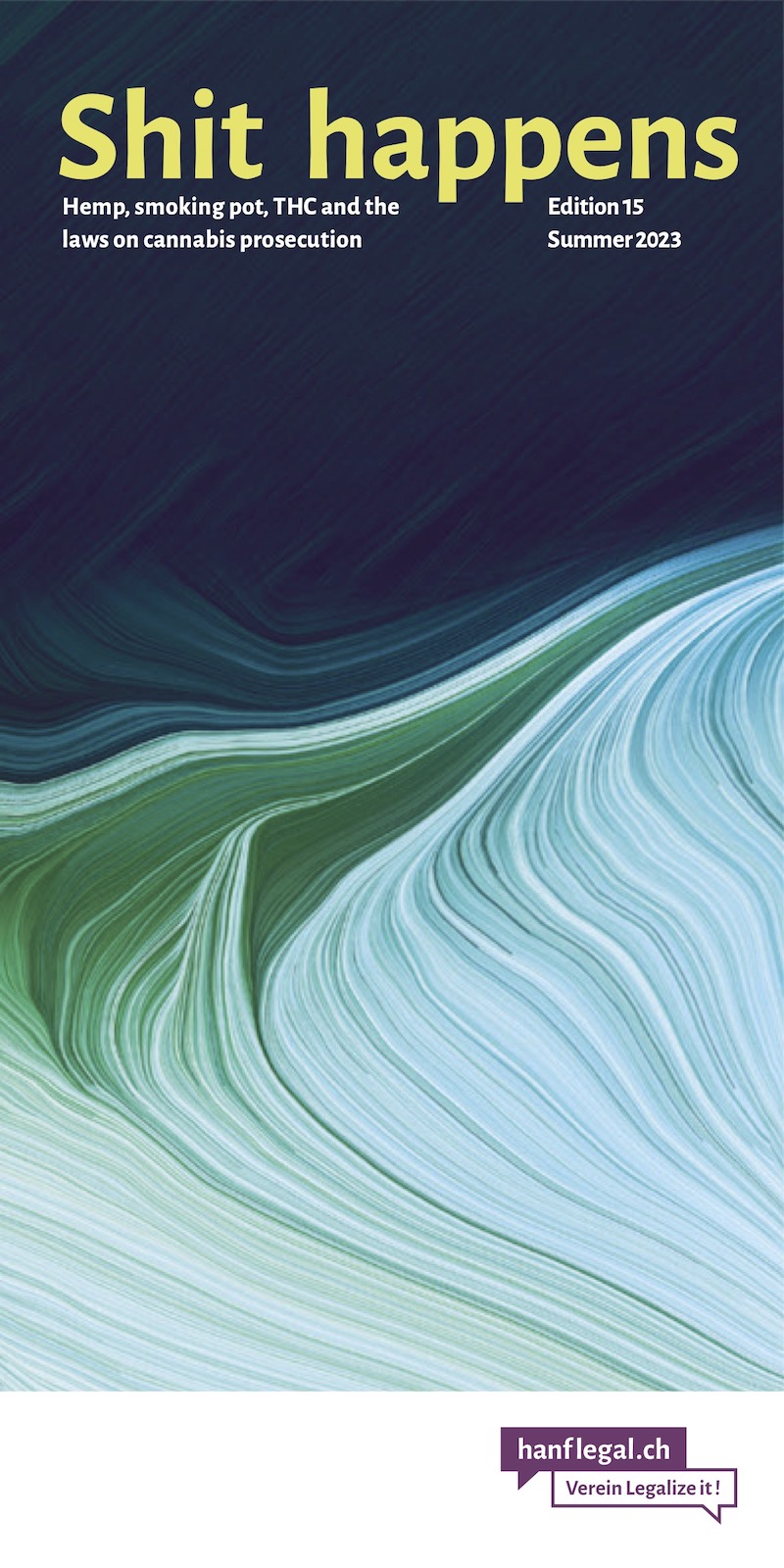- THC & Law:
The hemp prosecution in 2014
Another year of repression in numbers: In 2014, hemp prosecution again affected tens of thousands. However, for the first time in a long time, the numbers are somewhat declining - and the new fixed penalties are implemented differently in the cantons.
The prosecution of contraventions
Consumption of cannabis and all preparatory acts for own consumption (NarcA 19a) The hemp prosecution in Switzerland concerns with the users since some years every year about 40'000 different people, who were accused of 50'000 criminal offenses (consumption, as well as possession of hash and weed, cultivation, storage, importation for own use). This has essentially been the case in 2014 as well. However, 2014 is now the first complete year in which a part of the contraventions recorded by the police can end not with a report (and a fine with fees between 200 and 1,000 francs), but with a fixed penalty (uniformly 100 francs).
The statistics show that about one third of the hemp-contraventions punished by the police were now punished with fixed penalties (orange color in the graphs/tables). The other two thirds were still reported (in three different categories, which we have shown in green).
Two thirds of the repression: reprimands as before
34,544 offenses related to consumption and preparatory acts were reported; this involved 28,777 defendants. These referrals are divided into three categories: 1) “Consumption”, 2) “Cultivation/Preparation” and 3) “Possession/Securing”. These are each broken down by number of defendants and by number of offenses (but unfortunately not by canton). Thus, we have presented two graphs on page 3: The first on the left for the development in the number of defendants, the second on the right for the development by number of offenses.
In both, we also show for the first time the three categories (in green shades), so that one can see the changes. We add the fixed penalties in orange to both graphs. Even though the figures cannot be compared exactly in this way, they do give an impression of the volume and the shifts from the three categories of convictions to the new fixed penalties.
A third of repression: fixed penalties
All cantons now issue fixed penalties (OB). However, the differences are enormous. First, let's look at the absolute numbers: Just under 15,000 OBs for cannabis use were counted throughout Switzerland in 2014. Table 1 shows the figures for the individual cantons. Zurich, Vaud and St. Gallen together already account for half of all OB.
Now we put the numbers of OB in relation to the population size of the cantons, i.e.: How many OB are issued per 1,000 inhabitants? Table 2 shows the corresponding figures. Zug and Vaud can be regarded as the real fans of fixed penalty provisions, while Bern and Basel-Landschaft issue practically no OB.
But be careful: This does not mean that Bern is more liberal than Zurich, as some media have portrayed it. It only means that Zurich has almost certainly replaced a part of the reprimands with OB. Bern, on the other hand, has not: there, as it seems, people are still being reported to the police just as before.
Unfortunately, there is no hemp breakdown by canton. This exists only for all illegal narcotics. In 2013, there was a total of 97,289, then in 2014 suddenly only 80,986 crimes to record. The gap of 16,303 is pretty much in line with the level of the new OB: There were14,861 here.
At the cantonal level, this can also be seen in many cantons: For example, the canton of Berne has about the same number of NarcA-convictions as before and practically no OB, while Zurich has thousands of convictions less, but has created thousands of new OB. The situation is similar in Vaud. And: St. Gallen, on the other hand, already had OBs in the past, and here the number of convictions has remained constant. These are indications that some cantons continue to report as before, while others have replaced a substantial part of the reports with OBs.
Totaled reprimands and fixed penalties
Every reported crime is a police intervention, an intrusion into a person's private life. In this sense, OB can well be added to the reported crimes.
However, if one wants to know approximately how many different people have been affected by cannabis repression, then one must rather add the OB to the accused, even if the number of accused is still shown somewhat too high in this way (because individuals may well have received a report and an OB in one year, but this is not broken down in this way).
The changes 2013 to 2014
In any case, the first conviction category “consumption” has lost 7,151 defendants or 8,666 offenses, and the third “possession/securing” has lost 6,851 defendants or 7,895 offenses. (The second category, cultivation/manufacturing, remained about the same and has very few entries anyway). This results in a decrease of defendants by almost 14'000 and of reported offenses by about 16'500. We can see this in the graph by the clear decrease of the green bars.
However, the (new) OB have “only” increased by 12'663. Thus, for the first time in a long time, the prosecution intensity has slightly decreased, by about 1'500 defendants and about 4'000 offenses (and not increased, as one might think, if one compares only the change of the first prosecution category “consumption” with the OB, as the NZZ has done). OB are also given for mere possession (even if this is excluded by law).
Limitations of statistics
By the way: There are also convictions for hash and weed. These then end up in a category “Several substances”. However, all substances are included in this category. Only for the first category “consumption” a breakdown is shown: There, there are again 1,156 pure hemp-hemp cases per year. Extrapolated over all three categories, this should be about 2'000 more pure hemp consumption cases per year: So our graphs tend to show numbers that are too low. But the order of magnitude is clear: we are talking about tens of thousands of cases per year.
The prosecution of misdemeanor
Distribution as well as sale of cannabis (NarcA 19) The hemp prosecution in Switzerland has been affecting about 6,000 to 8,500 different people every year for several years in the giving away and selling of illegal hemp products, who were accused of 7,000 to 9,500 criminal offenses (passing on or selling hash and weed, cultivation, storage, importation for giving away or selling). This remained essentially the same in 2014, with 7,879 defendants charged with 8,804 offenses. (We list only the accused in the two graphs; the criminal offenses are simply higher by about 700 to 1,000 cases per year).
The two areas of the misdemeanor
misdemeanor are divided into two areas: “light case” (giving away and trading up to a few thousand francs) and “serious case” (turnover over 100,000 francs or profit of 10,000 francs, minimum 12 months imprisonment). Most misdemeanor prosecutions concern the “light case”. Here, the number of defendants decreased from 2013 to 2014 from 8,046 to 7,329. In the “serious” cases, the number of persons prosecuted remained practically the same: it increased from 536 to 550 persons.
Here, however, it must be seen that these are reprimands or reprimanded persons of one year. The statistics do not tell us how many and what sentences result from this. They only record the police referrals. In the case of consumption cases, the number of reprimands should also correspond roughly to the number of fines actually issued. However, in the case of misdemeanor, especially in serious cases, it can take months or even years for a verdict to become legally binding. In addition, there are always cases where someone is reported for a misdemeanor, but then, because there is no evidence, is “only” convicted of a contravention offense. Therefore: These figures do not indicate the number of sentences, but the number of people affected by police repression in this area.
The ratio of hash to weed
In the case of consumption acts, we cannot now make a breakdown by hash and weed because this information is not recorded at fixed penalties. However, this is still possible for misdemeanor. We see that there are many more referrals for weed (2014: 7,259 defendants) than for hash (2014: 620 defendants). Our category “Hash” includes the statistical categories hashish and hashish oil as well as the new category “Synthetic Cannabinoids”. Our “weed” category includes cannabis, hemp (young plant), hemp (plant dried), hemp (plant fresh), marijuana, and hemp seeds.
Source
Swiss Federal Statistical Office, Police Crime Statistics, Annual Reports 2009 to 2014: table of convictions by substance and table of fines (only for 2013 and 2014), and population figures from the 2013 statistics. Graphics and calculations by us.
Support our work with a donation:
Bank transfer
Account number (IBAN):
CH02 0900 0000 8709 1354 3
Full account details
Or scan this QR code with your eBanking App (ZKB, Revolut, Postfinance, …):

Or open/share the QR code as PDF file with your eBanking App.
Credit card
Donate via credit card
Verein Legalize it!
Quellenstrasse 25
8005 Zürich
Threema ID 7NH65RBY
Don’t miss anything! Follow us on social media:




